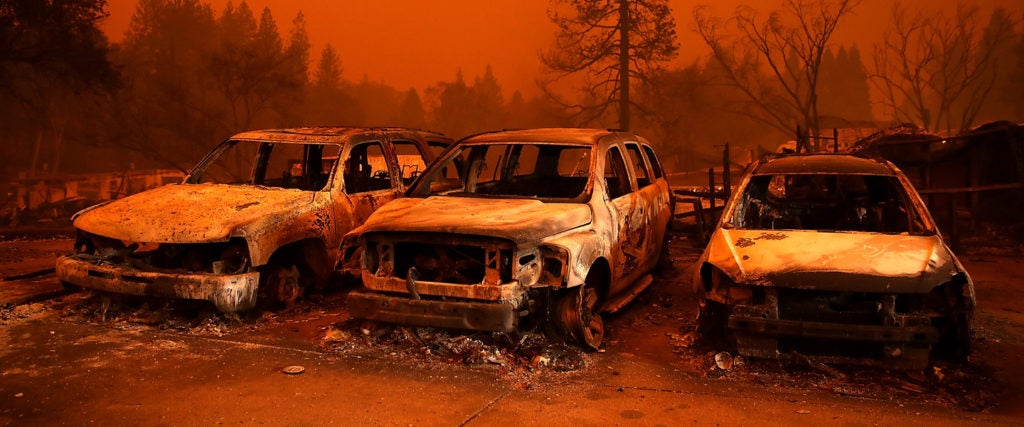One of my earliest memories is of Hurricane Andrew. Or, to be more accurate, newspaper coverage of it. I was seven years old in August 1992, vacationing with extended family in Long Island. I have an older cousin named Andrew, and one morning at breakfast, my uncle — his dad — showed me the cover of the New York Daily News, with a photo of the devastation wrought in Florida by the meteorological Andrew. “See what your cousin did?” he joked.
I got the quip, but it’s likely I remember it because of the image — buildings reduced to piles of splintered metal and wood, trees bent horizontal, cars overturned and smaller, unidentifiable objects scattered like confetti across the soggy landscape. It was my first inkling that humans are not guaranteed their homes or wellbeing, that something bigger could always come along to wipe you off the map. As an East Coast kid, I naturally considered hurricanes the greatest threat.
But after four years on the West Coast, I’ve come to wonder if these storms lend themselves to breathless national coverage in a way that other disasters don’t. The satellite imagery of a hurricane is distinctively ominous. There is a basic scale for categorizing its power. We get constant updates about its predicted path, how it will strengthen or weaken, where it will make landfall. For these reasons, there is usually time for orderly mass evacuations. Particularly after the horrors of Katrina, there’s an assumed understanding of concepts like “storm surge” floods and how levees and other embankments are supposed to protect cities. From inception to aftermath, hurricanes have a solid narrative, and the mainstream reporting reflects that.
You can’t say the same for West Coast wildfires, even when the havoc is unprecedented.
A densely populated metropolitan area is burning. If this was an East Coast city there would be non-stop media coverage. #GlendowerFire #Medford https://t.co/JBpNoNPHzx
— Hunk-er-downer ?️???? (@bestcoastginger) September 9, 2020
I keep seeing that the west coast is on fire but it can’t be that bad right pic.twitter.com/q0Zm6m1hvb
— mike (@MikeESchmee) September 9, 2020
This beautiful, troubling map shows how the smoke from California's wildfires have turned the Bay Area into a scene out of 'Blade Runner 2049' https://t.co/TVu2bcRNuq
— WIRED (@WIRED) September 9, 2020
Two years after its worst wildfire season in memory, the western U.S. is suffering the effects of massive conflagrations that stretch from California up through Oregon and Washington, as far southeast as Arizona and New Mexico, and north to Colorado, Idaho and Montana. The blazes have already broken new records — and not the good kind, obviously.
Journalism’s East Coast bias may account for the feeling, shared among many westerners, that coverage has not matched the scale nor impact of these hellish events. Likewise, for those who haven’t experienced them up close, the nature of wildfires remains elusive and ill-described. (Ditto earthquakes.) Though quite familiar with hurricanes as an adolescent in New Jersey, my scant awareness of California’s cyclical fires came from a SimCity 2000 level that placed you in charge of Malibu during a major inferno. “But why would it be burning?” I asked myself.
The destruction of indigenous ecological management during the Spanish colonial period and then post Gold Rush is directly tied to the state's fate today
California's ports and California's gold and California's ancient seabed made Americans rich and now California is burning
— césar miguel (@cesarmvm) September 8, 2020
today would be a good day to read our interview with Mike Davis about California overbuilding in areas meant to naturally burn and climate change being used as an excuse by government officials for manmade natural disasters ? https://t.co/KG7jQQDK2n
— Molly Lambert ? (@mollylambert) September 7, 2020
it's not as if the west coast doesn't have a lot of general moneyed privileges but the overwhelmingly democratic state & local governments are infuriatingly useless. they do not tax our rich, they do not cut our police budgets, they do not halt climate change actions.
— dante ? (@videodante) September 9, 2020
In respected news outlets, that question receives unsatisfactory answers. Sometimes the headlines zero in on a click-y, outrageous tale of human folly, such as when a so-called “gender reveal” pyrotechnic sets off a gigantic fire. This creates the false impression that wildfires are always preventable, or not a subtle ecological phenomenon. On the flip side, the ruling class of a largely Democrat-controlled West Coast can too easily blame the extreme climate for their contributions to the problem (and refusal to take the necessary, radical measures against it). Never do they, or mainstream media channels, touch upon how the colonization and short-sighted development of a place like California long ago set the stage for the current crisis.
Firefighters are written and posted about as if a branch of the military going to “war” with the flames; actually, they’re trained to work with wildland fire, which is not containable as the layperson would understand it, but occasionally malleable. They are managing a landscape, not snuffing out every last ember on it. The usual reliance on prison labor in this effort — a shameful secret in its own right — has combined with the fact of COVID-19 to reduce manpower this summer and fall.
Attempts to quantify what the fire response teams are dealing with rely on measurements that challenge or abuse the contemporary imagination: When you read that 2 million acres have burned in California, does it convey a tangible fact? Can you visualize a complex of fires roughly “the size of Connecticut,” and does this comparison tell us something about a failure to conceive the vastness of the west? And if the coastal schism is bad, it’s nothing compared to our unwillingness to discuss fire season as a global catastrophe. From Australia to the Amazon rainforest, the Mediterranean to Siberia, it’s getting worse everywhere.
The west coast truly is on fire. The map below depicts hotspots associated with fires identified via satellite (seen in red and orange), as well as the smoke produced by them. This map can be viewed on the @zoom_earth website: https://t.co/kXq5C311BD #Weather #California #Oregon pic.twitter.com/NrCW0FDZv2
— Modeling and Climatology (@AndClimatology) September 8, 2020
My state is on fire. Whole communities have already been destroyed, others are threatened as wildfires continue to grow. The reasons why are not a mystery. Things will get worse before they get better. And they won't get better at all unless we act #ClimateChange https://t.co/6YlrOaHFny
— Sanjay Srivastava (@hardsci) September 9, 2020
Clean air quality is typically graded between 0-20 on the DEQ app. Corvallis, OR has been nearing FOUR HUNDRED—graded as “extremely hazardous” to breathe. The worst air quality in the world right now. https://t.co/Lk76nDv5MR
— Mary Emily O'Hara @ #Brandweek (@MaryEmilyOHara) September 9, 2020
There are many blind spots in the telling of the wildfire story, and one important reason is that the fires defy simplification in an infosphere that lacks nuance. They are sprawling, diffuse, fast-moving patchworks of incendiary energy, and we struggle to model or predict their movements. They catch us unaware and unprepared. When not explained in terms of surface area or death count, they are likened, feebly although somewhat wondrously, to shots from recent apocalyptic movies, and when citizens document the noxious haze with their smartphones, the camera technology attempts to “correct” the eerie red-orange color.
Social platforms give us the aestheticized version of hours spent in a shroud of smoke, nothing of the physical toll — the dense, scorched particulate matter in the air makes it hard to breathe, and in the worst circumstances, difficult to think. It is brutally oppressive. It offers no instance of relief.
As winter arrives and the fires die down for a while, the destruction will be tallied in statistics — lives lost, buildings gone, square miles of forest charred. But this won’t tell you what it’s like to drive, as my girlfriend Maddie and I did, from southern Oregon down to L.A. without ever seeing the actual sky, or for her to learn that her mom and her fiancé had to flee their new home as the large metropolis north of them was engulfed in flames.
The dread is more than fearing for friends and family over the next few weeks. People from the West Coast, like Maddie, are looking into the future and confronting the idea that the only home they’ve known may be uninhabitable in their lifetime. That kind of ongoing, incalculable loss just isn’t in the common vocabulary, since we can barely wrap our suffocating brains around it.
To apprehend and survive the fires — or this pandemic, or climate change itself — we must now find the words.

